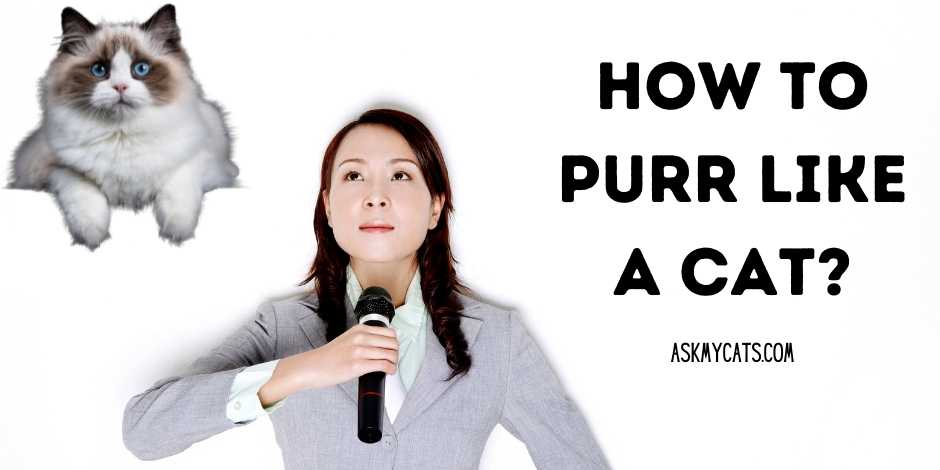Training to purr has come in handy as a cat owner.
It calms the cats, helps them trust me more, and speeds up and reinforces the emotional connection between them and me when used on new kittens.
The easiest way to purr like a cat is to use the sensitive palate in a manner comparable to a snore, except with the noise emanating from the lips rather than the nose, and with a lower pitch and sound.
Key Takeaways
- Some people have claimed to be able to purr like a cat, but it is not a common human ability.
- Humans do not have the same anatomy as cats, and we are not able to produce the same type of purring sound.
- While it may be possible for humans to make a vibrating noise that resembles cat purring, it is not the same as a genuine cat purr.
- Humans do not have the same laryngeal and diaphragmatic muscles as cats, which are responsible for producing the vibrating sound of a cat purr.
- While it may be fun to try to purr like a cat, it is important to remember that this is not a natural human ability, and it is not the same as a genuine cat purr.


Give Your Cat the Perfect Day
Get the Free Ebook!
Can Humans Purr Like A Cat?
Humans can make purring noises like cats and our vocal cords can be adjusted or set up to produce the sound.
A light flutter-tonguing, on the other hand, could have a similar result, but it might take a lot of practice to get it to be almost inaudible like a cat’s purring.
A flutter tongue is similar to the rolled R used in some Spanish words, except that you keep doing it instead of just doing it for a split second.
It may take some time for a cat to associate it with something as simple as purring. When I’ve done it with my cats, they normally just glare at me, as if to say, “What the hell are you doing?”

Set your upper – mid tongue to your soft palate and push air out from the point where they touch.
It’ll take some time, but the more you do it, the better you’ll get at it, and the easier it’ll be to adapt and make it sound like a real purr.
When I do this with kittens, they always respond by purring, and they always come running toward me.
Cats can purr when inhaling and exhaling, but humans can purr almost exclusively on the exhale.
Simply draw a fresh breath and make the noise again if you run out of breath.
Doing it over and over feels like a purr. You can pretty much imitate the rhythm of a cat’s purr using the technique I described – after a lot of practice, of course.
While I can and have made a vigorous vibration of my vocal cords to imitate a purr to one of the many cars I’ve had the pleasure of interacting with, human vocal cords are far too large to realistically imitate the sound of a domesticated cat.
With the exception of the cheetah, this sound is only heard by domesticated cats.
According to biologists and zoologists who have investigated this phenomenon, the scale of the vocal cords is believed to be the reason only house cats can produce this sound.
Now I use a soft, low vibration deep in the back of my throat to make your chest vibrate. All of the cats in my life have responded positively to this and would purr happily.
The only problem I’ve had is extending the sound without gasping for air.
Purring as a human employs a strategy that is more akin to growling.
Allow a constant stream of air to come straight from your diaphragm by pressing your lips together (but not fully closed) (if you play a wind instrument, this is a very similar feeling at first).
Allow your tongue to climb to the point that it is almost hitting the roof of your mouth. A faint purr can be heard if anything is performed right. This purr can become very persuasive and noisy with practice.
Breathing out when saliva is in the back of your mouth (roughly at the tip of your throat) normally works well.
It can take some time to get the right sound and feel relaxed, but it’s not difficult, and placing your tongue on the roof of your mouth will help. Only tweak it a little before it fits.
Begin to breathe from your teeth, as if you’re pretending to see your breath in the winter. Do that again and again.
Then press your tongue to the front of your mouth’s roof (making sure it’s flat) right behind the back of your front teeth, for example.
Don’t press it to the roof of your mouth; instead, remember how air is flowing through it like an air channel, and then bring your tongue closer to the roof. It should start shuddering on its own.
At first, go easy on it. Give it a shot. It ought to work. It could take a few breaths. Don’t exhale too quickly.
Must Read: Cat Purring Effect On Humans: The Power of Cat Purring
How To Imitate A Cat?
You can imitate a cat by instead of using words, using body language to express your emotions.

Like a cat, you can share your moods without saying something. If you’re bored or sleepy, turn around and leave the bed.
If you’re enjoying someone’s business, sit next to them and smile with your eyes closed to demonstrate that you’re content and happy.
And if you don’t have a tail or ears like a cat, you can always use your face to communicate your feelings to someone without saying something.
For example, if you’re anxious for dinner to be finished, you can walk back and forth or back away if you don’t want anyone to touch or hold you.
An experiment about the voice’s pitch. When you’re relaxed and satisfied, speak in a cheerful tone, and when you’re angry, add a growl to your accent.
You don’t have to meow in the same manner as a cat, so you can imitate their sounds.
Rats, for example, chirp and mew when they like someone, so when you see someone or something you like, you might make high-pitched, joyful squeals.
You should hiss like a cat when it’s insulted or annoyed to express your annoyance. If you wish to communicate with cats, try to imitate their meows and sounds as closely as possible. Pay attention to how they talk and imitate them.
Interesting Read: Why Does My Cat Purr And Bite Me?
Have a distinct odor. Cats interact with pheromones that humans are unable to detect in order to lure mates and scare other cats away. Choose a pleasant-smelling perfume or body wash so that people will want to be around you.
If you want to repel others, don’t wash your hands after cooking with garlic and onions or handling such foul-smelling materials.
To indicate that you like someone, blink slowly. People sometimes mistake cats for staring at them when, in fact, cats blink slowly to indicate that they like someone. To express love, blink steadily and evenly.
When you’re getting to know a new cat and want to show that you’re a friend, this is particularly useful. Some people do not understand this action, which may appear to be obnoxious. To be less threatening, consider batting your eyes steadily.
To warn anyone who is annoying you, swat them. If you ever find yourself in a confrontation, resist the urge to go all out and violently kill someone.
Rather, smack someone on the arm to warn them of an impending confrontation. Cats will bat at other cats, dogs, and humans to start a battle, and it doesn’t always have to escalate to a full-fledged fight.
An alert swat doesn’t have to be hard; it just needs to be fast and sharp enough to draw attention. Cats will bite and claw their rivals if a real battle occurs.
Only be careful and think about the implications of using these techniques in a real war.
Interesting Read: Why Does My Cat Lay On Me And Purr?
How To Purr Like A Cat With Your Mouth Closed?
You can purr like a cat with a closed mouth by calming your vocal cords, allowing them to flutter while you breathe, resulting in the all-too-familiar purring sound we all love.

Cat purrs are produced when the cat relaxes to the point that its vocal cords become floppy and loose. The purr is produced by merely breathing enough air past them to allow them to flutter.
You can hear the minor breaks as the cat moves from breathing in to breathing out and vice versa if you listen closely.
It’s real that people will purr almost as much as cats and other creatures. All people purr in their own unique way.
One of the most well-known is making a certain sound with your tongue pressed to the roof of your mouth. It sounds like a growl-slash snarl, and I do it all the time.
I can purr and make authentic cat noises that no one else can. I don’t purr with my mouth open; instead, I shut it and keep it straight.
Through my vocal cords, I can produce a deep rumble from which a sound can be released.
The echo is created by the chords in your throat colliding with one another. This enables a low or high-pitched rumble to be heard by those nearby.
The only thing is that it takes a lot of practice. I can’t breathe when doing this, which limits my ability to purr for long periods of time.
Although we’re not sure why cats purr with their mouths open, let’s hear more about the purr of a cat.
Purring is a cat’s special means of communicating and vocalizing, and each cat purrs differently. Some cats, on the other hand, do not purr at all.
A cat’s larynx vibrates between 25 and 150 times per second to make the purring sound, with fewer vibrations producing lower purrs and faster vibrations producing higher pitch purrs.
When air is released and breathed in, the purr resonates, creating sound changes. Surprisingly, cats don’t just purr to show that they’re happy. It may also be used to convey discomfort, anxiety, or tension.
It may be a symbol of self-healing and relaxation.
A cat’s purr may also indicate that it is self-soothing. When cats are in distress or injured, they purr. The purring sound they make is a kind of self-soothing, similar to how a child might pacify himself by sucking his thumb.
This is, though, where things start to get interesting. Did you know that purring aids in the recovery of cats?
According to studies, a cat’s purr causes a set of movements in its body that help strengthen and rebuild muscles and tendons, heal bones and bruises, reduce discomfort and swelling, and make breathing easier.
It’s amazing how far a cat’s purr can go, and how it’s used not only as a means of communication for animals but also as a means of self-healing and relaxation.
But what about a purring cat with its mouth open? Can it have the same connotation? Is it a symptom of a more serious medical problem or illness?
It’s completely normal if you hear your cat purring with its mouth open just after a vigorous play session or when running around chasing toys, and the cat returns to its normal purring style after a while.
However, if your cat is purring with its mouth open while doing nothing and the room temperature is normal, it’s time to take her to the vet.
In addition to the standard laboratory examinations, the veterinarian can need to perform X-rays on your cat to examine the airways, windpipes, and oral cavity.
Interesting Read: Why Does My Cat Drool When He Purrs?
Step-by-step Guide on How To Purr Like a Cat
1. Find a comfortable position
To purr like a cat, you will need to find a comfortable position that allows you to relax and breathe easily.
2. Make a vibrating sound
Cats purr by making a vibrating sound with their larynx (voice box) and diaphragm. To mimic this sound, you can try making a low, vibrating noise in your throat by humming or making a “brrr” sound.
3. Keep the sound going
Keep the vibrating sound going for as long as you can. It may take some practice to get the hang of it, but with time and patience, you should be able to purr like a cat.
4. Experiment with different tones
Cats can purr at a variety of different tones and frequencies, so don’t be afraid to experiment with different pitches and rhythms.
5. Practice regularly
The more you practice purring like a cat, the better you will get at it. Set aside some time each day to work on your purring skills, and you should see improvement over time.
Why It Is That Cats Purr And Humans Do Not?
Humans cannot purr exactly like cats because cats have a distinct larynx from humans. We can’t make the same noise because we don’t have their purr box.
It’s not that it counts. Your cat can say if you’re comfortable even if you don’t purr.
My feline overlord stares at me with an expression that means, “What on Earth are you doing?” as I try to make purring sounds with my tongue.
Training to purr has come in handy as a cat owner.
It calms the cats, helps them trust me more, and speeds up and reinforces the emotional connection between them and me when used on new kittens.
Some of the Interesting reads regarding cat purring:
- Why Do Cats Purr? The Science of Cat Purring
- Why Doesn’t My Cat Purr?
- How To Make A Cat Purr?
- Why Do Cats Purr When They Are Dying?
- Do Cats Purr When They Sleep?
- Why Does My Cat Purr When He Sees Me?
- Why Is My Cat Purring So Much?
- Why Does My Cat Purr So Loudly?
- Why Do Cats Purr When You Stroke Them?
- Can Cats Control Their Purring?
- Do Cats Purr When They Are Happy?
- Do Cats Breathe Faster When Purring?
- Why Do Cats Wag Their Tails While Purring?
- Differences In Purring Between Cat Breeds
- Why Do Cat’s Noses Get Wet When They Purr?
- Why Does My Cat’s Purring Sound Congested?
- Why Is My Pregnant Cat Purring So Much?
- Why Do Cats Purr And Knead?
- Do Cats Purr When They Are Sick Or In Pain?
- Do Feral Cats Purr?
- Why Do Cats Purr When You Talk To Them?
Frequently Asked Questions
Are cats happy when they purr?
When cats are in a comfortable setting, they can purr, sending out bursts of calmness. This will even happen when you pet them, indicating that your feline companion is comfortable or sociable. Cats, on the other hand, purr to express a variety of desires and wants.
How do you purr with your tongue?
Breathe out while vibrating your tongue and vocalizing a purring sound with your lips open, with the front half of your tongue against the roof of your mouth.
Final Words
The human vocal cords are much too large to produce a sound that is comparable to that of a domesticated cat.
With the exception of the cheetah, this sound is rarely heard by domesticated cats.
According to biologists and zoologists who have investigated this phenomenon, the scale of the vocal cords is believed to be the reason only house cats can produce this sound.
Now I use a soft, low vibration deep in the back of my throat to make your chest vibrate. All of the cats in my life have responded positively to this and would purr happily.
The only problem I’ve had is extending the sound without gasping for air.
Drop down your questions in the comments section below!
